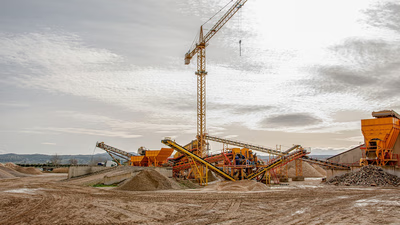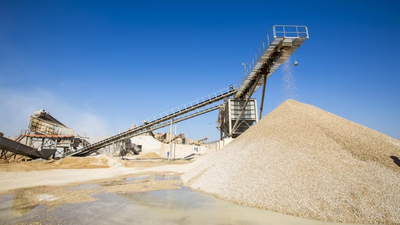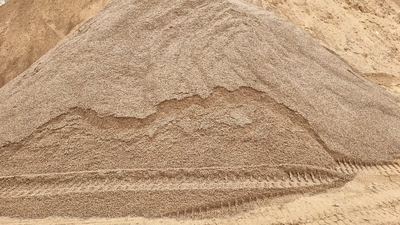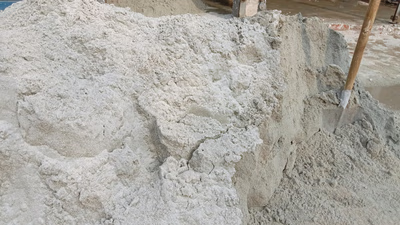
Sand extraction methods in Middle East trade platforms.
Sand is typically extracted from natural sources through different methods, depending on the location and type of deposit. In areas with water bodies like rivers, lakes, or coastal regions, dredging involves using large machines equipped with buckets or suction devices to scoop or vacuum sand from the bottom. In land-based sources, sand can be extracted through quarrying, which involves removing overlying materials and excavating the sand deposit from the ground. Once extracted, the raw sand may undergo processing to remove impurities and enhance its quality and suitability for specific applications. The processing steps can include:
The raw sand is usually screened to separate larger particles and debris, ensuring a more consistent particle size distribution. Sand may undergo washing to remove finer particles, silt, clay, and organic matter, which can affect its quality and performance in certain applications like concrete production. Sand can be graded and sorted based on particle size to meet specific requirements. Different grades of sand may have varying applications and uses. In some cases, sand may be dried to remove excess moisture, particularly when it is used in applications where moisture content is critical, such as sand casting or certain industrial processes.
Sand is formed by the erosion or breaking of pebbles and the weathering of rocks. These stones are carried by seas or rivers. Freezing of water inside rock cavities during winter creates sand. Sometimes sand on beaches can also be made up of small broken pieces of coral, bones and shells that are broken up by predators and then beaten up by the sea. When they create an explosion in the mine, the pure rock resulting from the explosion or crushing by the excavator hammer is transported to the first production line of the factory by truck after being loaded in the mine and is discharged into the hopper.
The material discharged inside the hopper is guided by a chain feeder into the stone crusher of the factory called Faki, and after initial crushing, it is resized to about 20 to 30 cm. Now, these stones are guided by a conveyor belt into the next stage stone crusher, which is called Qubit, and it is crushed again until it reaches the dimensions of sand that can be used and consumed. The sands and sands from this section are directed to the three-story sand for separation, and the pea sand, almond sand, overseas sand and broken sand products are separated. And they are taken to the product depot through collection conveyors. Finally, the final product is transported to consumer markets by a loaded loader.
After processing, the sand is typically transported to its intended destination. Transportation methods depend on the scale of production and the distance involved. Sand can be transported by trucks over short to medium distances, typically within a regional or local area. For longer distances or when large quantities of sand need to be transported, rail or barge transportation may be used. This method is often employed when sand is sourced from coastal areas or riverbeds. Responsible sand production takes into account environmental considerations and follows regulations to minimize ecological impacts. This includes measures to mitigate the disturbance to ecosystems, protect water bodies, and restore the extraction sites after the process is complete.
-

Sand is essential in construction, enhancing materials like concrete and mortar. Its physical properties improve cohesion, workability, and durability of building components. Sand fills voids between aggregates, reducing shrinkage and cracking risks. Different sand types allow for specific textures in plastering and rendering. It provides stability in structures, supports drainage systems, and is used in various applications such as glass production and metal casting molds. The quality of sand affects its efficiency; washed sand is preferred for better adhesion in cement mixtures. Sustainable sourcing practices are crucial to minimize environmental impacts. Sand"s versatility makes it a cost-effective choice for construction projects globally. "
-

Various types of sand serve distinct purposes in construction and industry. River sand, known for its well-rounded grains, is ideal for concrete and plastering. Beach sand, derived from coastal areas, is often used in landscaping due to its fine particles. Pit sand, extracted from quarries, is coarser and suitable for filling trenches. Natural sand, available in red and orange hues, is used in concreting due to its sharp fractures. Fill sand is utilized for voids and low-lying areas, while synthetic sands are produced from crushed stones as alternatives to river sands. Other types include washed sand, light-grained sand, ordinary sand, heavy grain sand, broken sand, round sand, angled sand, semi-round sand, and mixed sand. Crushed stone sand (M-Sand) is a popular substitute for river sand in construction due to its angular grains.
Silica sand has high industrial value with applications in glass manufacturing and hydraulic fracturing. Desert sand is unsuitable for construction because of its smooth grains that lack cohesion.
-

Sand extraction involves various methods tailored to the deposit"s location, including dredging in water bodies and quarrying on land. The process begins with the removal of overlying materials, followed by screening to ensure consistent particle size. Washing is essential to eliminate impurities like silt and clay, which can affect quality for applications such as concrete production. Sand grading is crucial for meeting specific requirements, while drying may be necessary for moisture-sensitive uses. The formation of sand results from erosion and weathering processes, with transportation methods varying based on production scale and distance. Short distances typically utilize trucks, while rail or barge transport is preferred for larger quantities over longer distances. Environmental considerations are paramount in responsible sand production, ensuring minimal ecological impact through regulations and restoration efforts post-extraction. "
-

The construction industry is the largest consumer of sand, utilizing it in concrete, asphalt, and mortar. Urbanization and infrastructure projects drive demand, particularly in developing countries. Sand extraction occurs from riverbeds and coastal areas but poses environmental risks such as habitat destruction and biodiversity loss. The global annual consumption of sand is approximately 53 billion tons, with significant usage in East Asia. Despite its abundance, not all sand types are suitable for construction, leading to shortages and illegal mining practices. Efforts to promote sustainable sand management include regulations, alternative materials, and recycling initiatives. Organizations like UNEP advocate for better governance to mitigate environmental impacts associated with sand mining.
-

Sand is a granular material essential in construction, formed through weathering and erosion of rocks. It consists mainly of quartz and other minerals, with its properties varying based on particle size, shape, and composition. Sand is classified into types such as soft sand for mortar mixes and sharp sand for concrete production. The shape of sand particles affects the stability and workability of construction materials; angular particles provide better interlocking while rounded ones enhance mix cohesion. Sand is also used in landscaping and sports fields. However, environmental concerns arise from excessive sand mining, leading to habitat destruction and ecological imbalances. Sustainable alternatives like manufactured and recycled sand are being explored to mitigate these impacts. The quality of sand varies by region, influencing its suitability for different applications in the construction industry.





